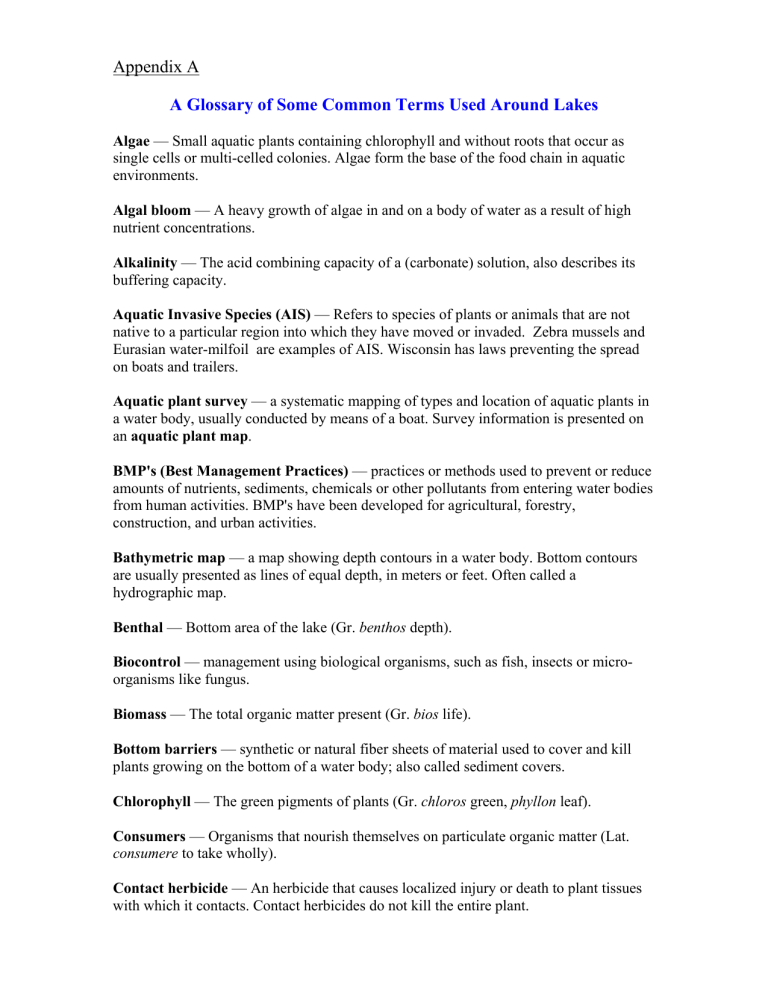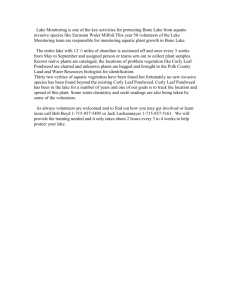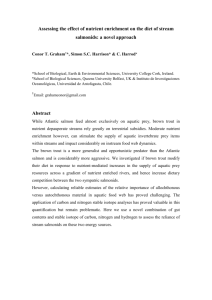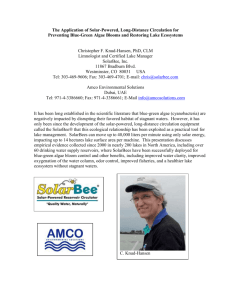Appendix A A Glossary of Some Common Terms Used Around Lakes

Appendix A
A Glossary of Some Common Terms Used Around Lakes
Algae — Small aquatic plants containing chlorophyll and without roots that occur as single cells or multi-celled colonies. Algae form the base of the food chain in aquatic environments.
Algal bloom — A heavy growth of algae in and on a body of water as a result of high nutrient concentrations.
Alkalinity — The acid combining capacity of a (carbonate) solution, also describes its buffering capacity.
Aquatic Invasive Species (AIS) — Refers to species of plants or animals that are not native to a particular region into which they have moved or invaded. Zebra mussels and
Eurasian water-milfoil are examples of AIS. Wisconsin has laws preventing the spread on boats and trailers.
Aquatic plant survey — a systematic mapping of types and location of aquatic plants in a water body, usually conducted by means of a boat. Survey information is presented on an aquatic plant map .
BMP's (Best Management Practices) — practices or methods used to prevent or reduce amounts of nutrients, sediments, chemicals or other pollutants from entering water bodies from human activities. BMP's have been developed for agricultural, forestry, construction, and urban activities.
Bathymetric map — a map showing depth contours in a water body. Bottom contours are usually presented as lines of equal depth, in meters or feet. Often called a hydrographic map.
Benthal — Bottom area of the lake (Gr. benthos depth).
Biocontrol — management using biological organisms, such as fish, insects or microorganisms like fungus.
Biomass — The total organic matter present (Gr. bios life).
Bottom barriers — synthetic or natural fiber sheets of material used to cover and kill plants growing on the bottom of a water body; also called sediment covers.
Chlorophyll — The green pigments of plants (Gr. chloros green, phyllon leaf).
Consumers — Organisms that nourish themselves on particulate organic matter (Lat. consumere to take wholly).
Contact herbicide — An herbicide that causes localized injury or death to plant tissues with which it contacts. Contact herbicides do not kill the entire plant.
Decomposers — Organisms, mostly bacteria or fungi, that break down complex organic material into its inorganic constituents.
Detritus — Settleable material suspended in the water: organic detritus, from the decomposition of the broken down remains of organisms; inorganic detritus, settleable mineral materials.
Dissolved oxygen — A measure of the amount of oxygen gas dissolved in water and available for use by microorganisms and fish.
Drainage basin — The area drained by, or contributing to, a stream, lake, or other water body (see watershed).
Drawdown — Decreasing the level of standing water in a water body to expose bottom sediments and rooted plants. Water level drawdown can be accomplished by physically releasing a volume of water through a controlled outlet structure or by preventing recharge of a system from a primary external source.
Dredging — A physical method of digging into the bottom of a water body to remove sediment, plants or other material. Dredging can be performed using mechanical or hydraulic equipment.
Ecology — A scientific study of relationships between organisms and their surroundings
(environment).
Ecosystems — Any complex of living organisms together with all the other biotic and abiotic (non-living) factors which affect them.
Emergent plants — Aquatic plants that are rooted or anchored in the sediment around shorelines, but have stems and leaves extending well above the water surface. Cattails and bulrushes are examples of emergent plants.
Endothall — The active chemical ingredient of the aquatic contact herbicide Aquathol
®
.
Epilimnion — The uppermost, warm, well-mixed layer of a lake (Gr. epi on, limne lake).
Eradication — Complete removal of a specific organism from a specified location, usually refers to a noxious, invasive species. Under most circumstances, eradication of a population is very difficult to achieve.
Euphotic zone — That part of a water body where light penetration is sufficient to maintain photosynthesis.
Eutrophic — Waters with a good supply of nutrients and hence a rich organic production
(Gr. eu well, trophein to nourish).
Exotic — Refers to species of plants or animals that are not native to a particular region into which they have moved or invaded. Eurasian water-milfoil is an exotic plant invader.
Floating-leafed plant — Plants with oval or circular leaves floating on the water surface, but are rooted or attached to sediments by long, flexible stems. Waterlilies are examples of rooted floating-leafed plants.
Fluridone — The active chemical ingredient of the systemic aquatic herbicide SONAR
®
.
Flushing rate — Term describing rate of water volume replacement of a water body, usually expressed as basin volume per unit time needed to replace the water body volume with inflowing water. The inverse of the flushing rate is the (hydraulic) detention time. A lake with a flushing rate of 1 lake volume per year has a detention time of 1 year.
Freely-floating plants — Plants that float on or under the water surface, unattached by roots to the bottom. Some have small root systems that simply hang beneath the plant.
Water hyacinth and tiny duckweed are examples of freely-floating plants.
Glyphosate — The active chemical ingredient of the systemic herbicide RODEO
®
.
Grass carp — Also known as white amur, grass carp is a large, vegetation-eating member of the minnow family ( Ctenopharyngodon idella ). Originally from Russia and
China, these plant grazers are sometimes used as biological agents to control growth of certain aquatic plants. Regulated use of sterile (non-reproducing) grass carp has been recently permitted in Washington State for aquatic plant control.
Herbicide — A chemical used to suppress the growth of or kill plants.
Habitat — The physical place where an organism lives.
Hydraulic detention time — The period of detention of water in a basin. The inverse of detention time is flushing rate. A lake with a detention time of one year has a flushing rate of 1 lake volume per year.
Hypolimnion — The cold, deepest layer of a lake that is removed from surface influences (Gr. hypo under, limne lake).
Limiting nutrient — Essential nutrient needed for growth of plant organism which is the scarcest in the environment. Oftentimes, in freshwater systems, either phosphorus or nitrogen may be the limiting nutrient for plant growth.
Limnology — The study of fresh water (Gr. limne lake).
Littoral — The region of a body of water extending from shoreline outward to the greatest depth occupied by rooted aquatic plants.
Macro-algae — Large, easily seen (macroscopic) algae. The macro-algae Nitella sp. sometimes forms dense plant beds and can be a conspicuous member of the aquatic plant community.
Macrophyte — Large, rooted or floating aquatic plants that may bear flowers and seeds.
Some plants, like duckweed and coontail, are free-floating and are not attached to the
bottom. Occasionally, filamentous algae like Nitella sp. can form large, extensive populations and be an important member of the aquatic macrophyte community.
Mitigation — Actions taken to replace or restore animals or plants that may have been damaged or removed by certain prior activities.
Morphology — Study of shape, configuration or form (Gr. morphe form, logos discourse).
Niche — The position or role of an organism within its community and ecosystem.
Nitrogen — A chemical constituent (nutrient) essential for life. Nitrogen is a primary nutrient necessary for plant growth.
Non point (pollutant) source — A diffuse source of water pollution that does not discharge through a pipe or other readily identifiable structure. Non point pollution typically originates from activities on land and the water. Examples of non point sources are agricultural, forest, and construction sites, marinas, urban streets and properties.
Non-target species — A species not intentionally targeted for control by a pesticide or herbicide.
Noxious weed — A non-native plant species that, because of aggressive growth habits, can threaten native plant communities, wetlands or agricultural lands.
Nutrient — Any chemical element, ion, or compound required by an organism for the continuation of growth, reproduction, and other life processes.
Oligotrophic — Waters that are nutrient poor and have little organic production (Gr. oligos small, trophein to nourish).
Oxidation — A chemical process that can occur in the uptake of oxygen. pH — The negative logarithm of the hydrogen ion activity. pH values range from 1-10
(low pH values are acidic and high pH levels are alkaline).
Phosphorus — A chemical constituent (nutrient) essential for life. Phosphorus is a primary nutrient necessary for plant growth.
Photosynthesis — Production of organic matter (carbohydrate) from inorganic carbon and water in the presence of light (Gr. phos , photos light, synthesis placing together).
Phytoplankton — Free floating microscopic plants (algae) (Gr. phyton plant).
Point (pollutant) source — A source of pollutants or contaminants that discharges through a pipe or culvert. Point sources, such as an industrial or sewage outfall, are usually readily identified.
Pollutant — A contaminant, a substance that is not naturally present in water or occurs in unnatural amounts that can degrade the physical, chemical, or biological properties of the water. Pollutants can be chemicals, disease-producing organisms, silt, toxic metals, oxygen-demanding materials, to name a few.
Primary production — The rate of formation of organic matter or sugars in plant cells from light, water and carbon dioxide (Lat. primus first, producere to bring forward).
Algae are primary producers.
Problem statement — A written description of important uses of a water body that are being affected by the presence of problem aquatic plants. See Chapter 3.
Producers — Organisms that are able to build up their body substance from inorganic materials (Lat. producere to bring forward).
Public Trust Doctrine — A body of law Programs having roots in Roman law, English common law and the North West Ordinance of 1787. It grants authority to the state to regulate it’s waters, it establishes public rights of use and defines state property rights in navigable waters.
Residence time — The average length of time that water or a chemical constituent remains in a lake.
Rotovation — A mechanical control method of tilling lake or river sediments to physically dislodge rooted plants. Also known as bottom tillage or derooting.
Secchi disc — A 20-cm (8-inch) diameter disc painted white and black in alternating quadrants. It is used to measure light transparency in lakes.
Sediment — Solid material deposited in the bottom of a basin.
Sensitive areas — Critical areas in the landscape, such as wetlands, aquifer recharge areas, and fish and wildlife habitat conservation areas, that are protected by state law
(Growth Management Act of 1990).
Standing crop — The biomass present in a body of water at a particular time.
Steering committee — A small group of people organized to represent the larger community of individuals, businesses and organizations who have an interest in management of a particular water body. The steering committee is responsible for following the planning steps outlined in this manual.
Stratification — Horizontal layering of water in a lake caused by temperature-related differences in density. A thermally stratified lake is generally divided into the epilimnion
(uppermost, warm, mixed layer), metalimnion (middle layer of rapid change in temperature and density) and hypolimnion (lowest, cool, least mixed layer).
Submersed plants — An aquatic plant that grows with all or most of its stems and leaves below the water surface. Submersed plants usually grow rooted in the bottom and have thin, flexible stems supported by the water. Common submersed plants are milfoil and pondweeds.
Susceptibility — The sensitivity or level of injury demonstrated by a plant to effects of an herbicide.
Systemic herbicide — An herbicide in which the active chemicals are absorbed and translocated within the entire plant system, including roots. Depending on the active ingredient, systemic herbicides affect certain biochemical reactions in the plant that can cause plant death. SONAR
®
and RODEO® are systemic herbicides.
Thermal stratification — Horizontal layering of water in a lake caused by temperaturerelated differences in density. A thermally stratified lake is generally divided into the epilimnion (uppermost, warm, mixed layer), metalimnion (middle layer of rapid change in temperature and density) and hypolimnion (lowest, cool, least mixed layer).
Thermocline — (Gr. therme heat, klinein to slope.) Zone (horizontal layer) in water body in which there is a rapid rate of temperature decrease with depth. Also called metalimnion, it lies below the epilimnion.
Topographic map — A map showing elevation of the landscape in contours of equal height (elevation) above sea level. This can be used to identify boundaries of a watershed.
Transect lines — Straight lines extending across an area to be surveyed.
Tributaries — Rivers, streams or other channels that flow into a water body.
Triclopyr — The active ingredient of a systemic herbicide being evaluated in
Washington for aquatic plant control.
Triploid — A genetic term referring to non-reproducing (sterile) forms of grass carp induced by manipulating reproductive genes. Reproducing grass carp have two pairs of chromosomes and are termed diploid. Triploid fish have three sets of chromosomes.
Trophic state — Term used to describe the productivity of the lake ecosystem and classify it as oligotrophic (low productivity, "good" water quality), mesotrophic
(moderate productivity), or eutrophic (high productivity; "poor" water quality).
Vascular plant — A vascular plant possesses specialized cells that conduct fluids and nutrients throughout the plant. The xylem conducts water and the phloem transports food.
Water body usage map — A map of a water body showing important human use areas or zones (such as swimming, boating, fishing) and habitat areas for fish, wildlife and waterfowl. See Chapter 7.
Watershed — The entire surface landscape that contributes water to a lake or river. See drainage area.
Watershed management — The management of the natural resources of a drainage basin for the production and protection of water supplies and water-based resources.
Wetland — A generalized term for a broad group of wet habitats. Wetlands are areas of vegetation that are transitional between land and water bodies and range from being permanently wet to intermittently water covered.
Zooplankton — Microscopic animal plankton in water (Gr. zoion animal). Daphnia sp. or water fleas are freshwater zooplankton.
Thank you to the Washington State Department of Ecology; Maribeth Gibbons Jr. http://www.ecy.wa.gov/programs/wq/plants/management/manual/





